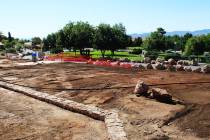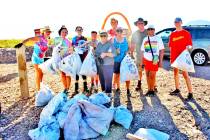Lake Mead visits up slightly
Thanks for nothing, Honest Abe.
Despite a slight increase in traffic last year, Lake Mead National Recreation Area has dropped to sixth on the list of the most visited national park sites. Replacing it at No. 5: the Lincoln Memorial.
Data released recently by the National Park Service show Lake Mead drew more than 6.3 million visitors in 2013. That’s up about 60,000 from 2012, despite a government shutdown that closed the park for 16 days in October.
Even so, the 1.5 million acre park in Nevada and Arizona was overtaken by the Lincoln Memorial, which attracted almost 6.6 million visitors last year.
In 2012, Lake Mead outdrew the Lincoln Memorial by about 100,000 people.
Golden Gate National Recreation Area in San Francisco topped the list with 14.3 million visitors. Blue Ridge Parkway (12.9 million) was second; Great Smoky Mountains National Park (9.4 million) was third; and George Washington Memorial Parkway (7.4 million) was fourth.
More than 273.6 million people visited the 401 parks, historic sites and recreation areas that make up the National Park System in 2013.
This marks the 75th year that the Park Service has ranked Lake Mead among its top 10 most visited sites.
Lake Mead spokeswoman Christie Vanover said the increase in park visitation in 2013 related partly to a spike in traffic at Katherine Landing on Lake Mohave, near Laughlin, which drew 1.3 million people last year, up from 969,000 in 2012.
Vanover said it’s hard to pinpoint Katherine Landing’s surge in popularity, but it could have something to do with Lake Mohave itself. There is much less fluctuation in the water level at the reservoir below Hoover Dam than at the one above.
“Lake Mohave offers more consistency to the boater who visits the park regularly,” she said.
Lake Mead’s Boulder Basin, just off U.S. Highway 93 in Boulder City, continued to be the park’s most popular area, with 1.6 million visitors.
Lake Mead was created in 1935 with the construction of the Hoover Dam. In 1936, the National Park Service began to manage the lake’s recreational uses under an agreement with the Bureau of Reclamation.
More than 390 million people have visited the park since 1937.
Public law officially established Lake Mead as the National Park Service’s first national recreation area in 1964. The park welcomed 3.4 million visitors that year.
Annual visitation has dropped by about 800,000 since 2010 and by more than 3.5 million since 1995, when it peaked at 9.8 million.
Vanover said vehicle traffic counters and “a mathematical formula” are used to track annual visitation.
Lake Mead’s visitor numbers don’t include traffic on state Route 165 to Nelson’s Landing and Placer Cove or along the 23-mile stretch of U.S. 93 that crosses through the park.
Visitors to Hoover Dam and the Hoover Dam bypass bridge are excluded from Lake Mead’s totals because those sites are not managed by the Park Service, Vanover said.
Contact reporter Henry Brean at hbrean@reviewjournal.com or 702-383-0350. Follow him on Twitter at @RefriedBrean.











